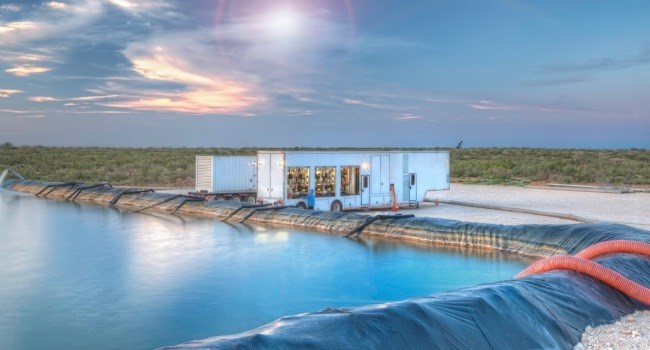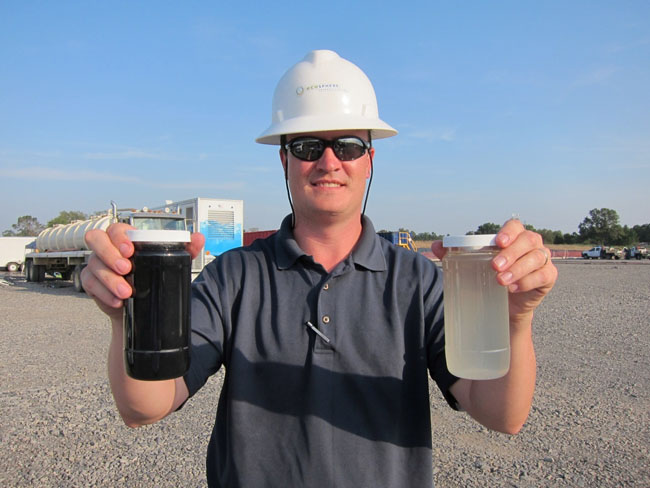Fracking Wastewater Recycled In Four Innovative Steps

By Laura Martin

Individually, electrochemical oxidation, ozone, hydrodynamic cavitation, and acoustic cavitation are all advanced, effective stand-alone disinfection technologies. But together they form what could be the complete water recycling solution the oil and gas industry is looking for.
“Each of these technologies enhances the other,” said Corey McGuire of Ecosphere Technologies. The Florida-based company developed Ozonix, a new chemical-free system that uses all four disinfection technologies to treat and recycle flowback and produced water for use as fracturing fluid. “Ozonix integrates these four technologies into one treatment process that has the ability to treat very high volumes of water in a very small footprint.”
While other companies have used two or three of the four technologies that make up the Ozonix system in conjunction, Ecosphere Technologies pioneered the concept of combining all four. They hold six patents on the various components of the Ozonix system.
“When hydraulic fracking — which requires a large amount of water — first starting becoming a trend, we saw the growing need for this type of technology,” said Robert Cathey, CEO of Fidelity National Environmental Solutions, a partner company of Ecosphere that was created to deploy the Ozonix technology in the oil and gas industry. “Our goal has always been to find unique solutions that improve environmental sustainability.”
Ozonix benefits the environment on multiple levels. It eliminates the need for tanker trucks to haul away flowback and produced water, the need for injection wells (which have been linked to earthquakes) and the need to use clean water resources as fracturing fluid (particularly important in areas dealing with water scarcity). It is also cuts out the need for liquid chemical biocides to manage microbial growth, as the fracturing fluid produced by the Ozonix process is bacteria-free and scale-free.
The system is completely mobile and can process up to 3,300 gallons per minute directly at oil and gas production sites. There is no secondary waste byproduct, and no additional treatment is needed.
“Most water treatment technologies in the oil and gas space are used at offsite locations to treat the produced water, but we treat 100 percent of the water volume going down the hole at the well site,” explained McGuire. “So our customers can reuse a lot of their recycled fluid in real time at the well site.”

Produced water shown before and after going through the Ozonix system
How It Works
The Ozonix system can be scaled up or down for use with various sized operations. Depending on the amount of water that needs to be disinfected, customers can choose from a trailer-based system, a frac tank -based system, or a small system housed in a 10’ by 8’ portable container.
All three system configurations run the produced water through all four disinfection technologies starting with ozone, which has the ability to oxidize a wide range of pollutants including bacteria and heavy metals. Ozone purifies water significantly faster than chlorine, penetrating cell walls and breaking bacteria cells apart.
Following ozone treatment, the water is further disinfected through hydrodynamic cavitation — a physiochemical process that raises water temperatures to over 900 degrees F to create a cavitating bubble. This causes a sonochemical reaction to occur, which converts the ozone into hydroxyl radicals.
Next, the water is treated using acoustic cavitation. This is a similar process to hydrodynamic cavitation, except acoustic cavitation uses sound waves to produce localized hot spots that raise water temperatures to over 6000 degrees K. The process is extremely effective at removing biofilms because it decreases the tensile stress of water, which causes the breakdown of bacteria clusters.
The final step in the Ozonix system is electrochemical oxidation. This technology uses electricity to create hydroxyl radicals. It effectively removes sulfides, nitrogen species, and up to 99 percent of iron in water sources. It can also remove calcium carbonate from water — a primary source of scaling.
Looking Forward
Currently the Ozonix system is used primarily in the U.S. oil and gas industry. Fidelity National Environmental Solutions has plans to expand the technology into Canada — a growing site for oil and gas production — in the near future. There are also plans to market Ozonix outside of the oil and gas industry in the next few years.
“The next industry we are going to focus most on is the mining industry, but Ozonix also has potential in the heavy oil, electrical power, agriculture, and even municipal spaces,” said McGuire of Ecosphere Technologies. “We want to deploy Oxinox across as many industries as we can touch.”
For more fracking wastewater recycling technologies check out Water Online's Produced Water page.
